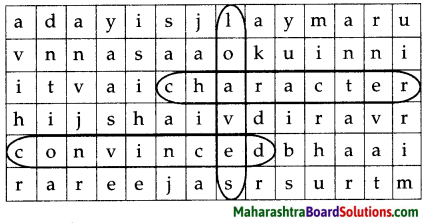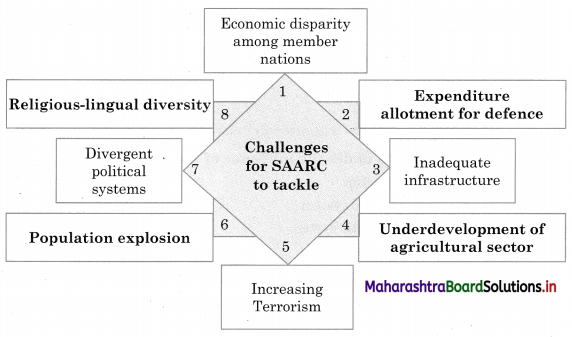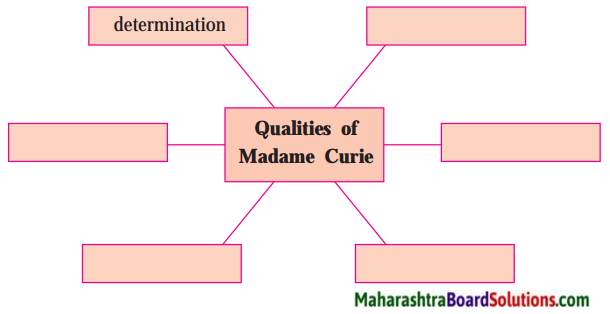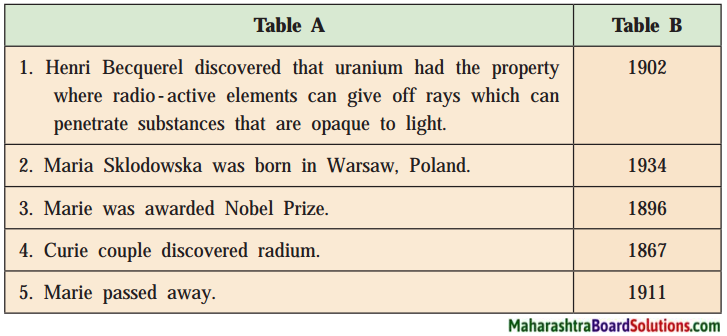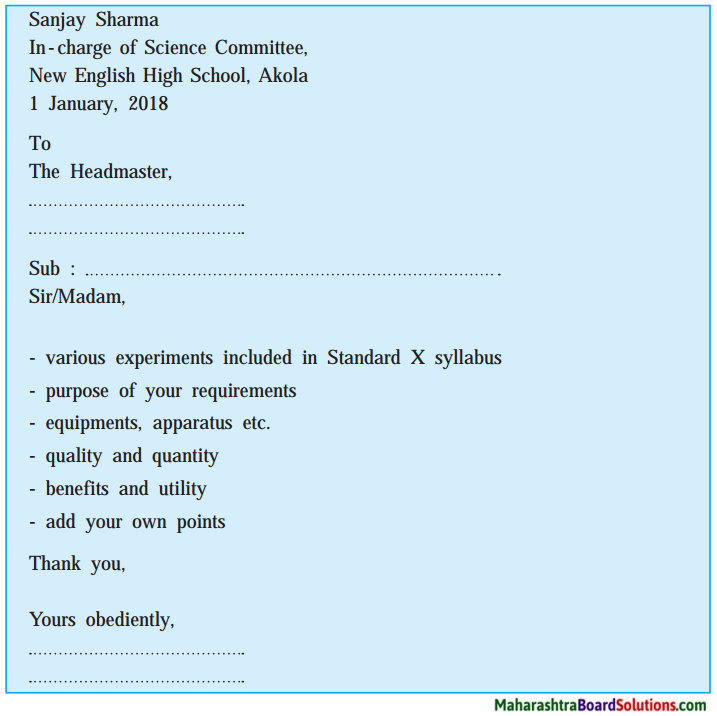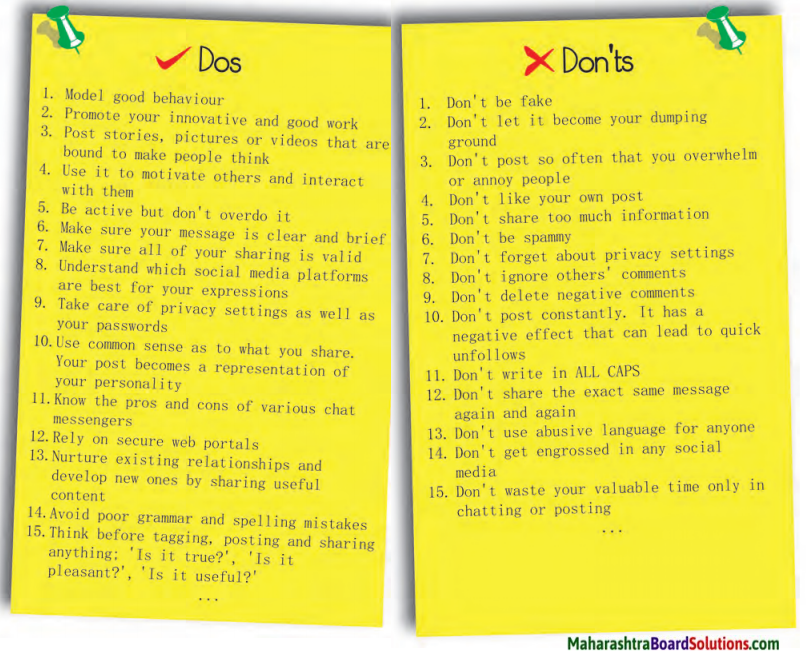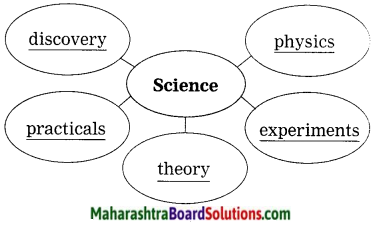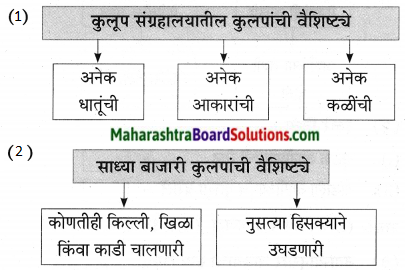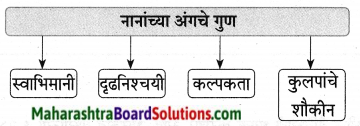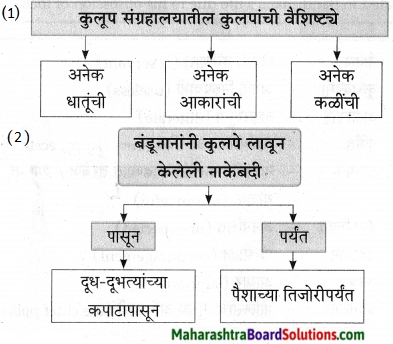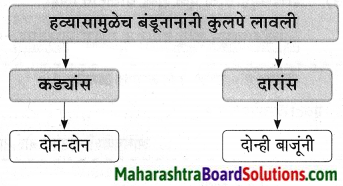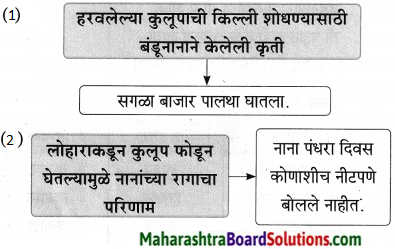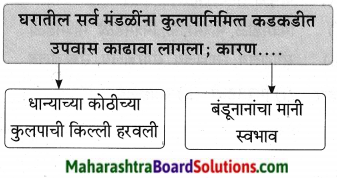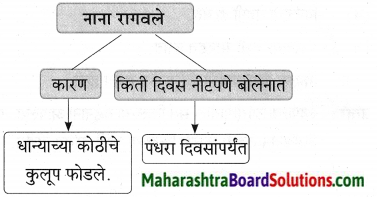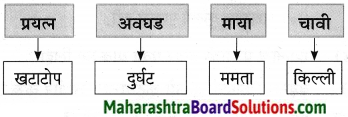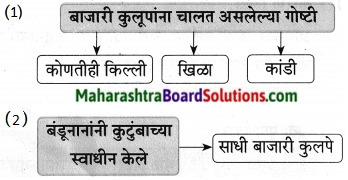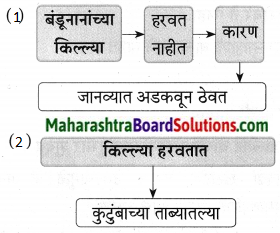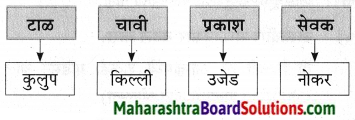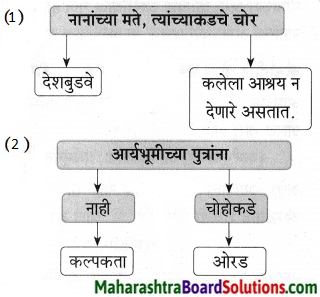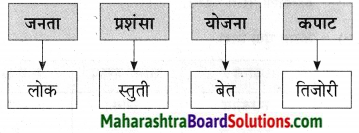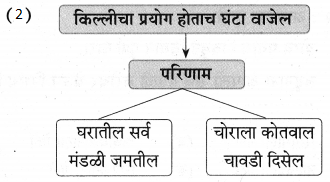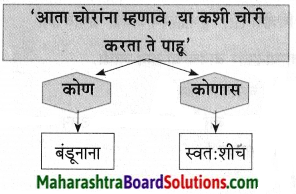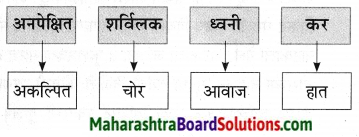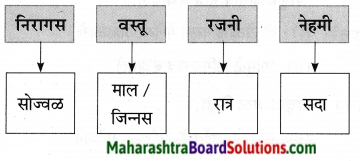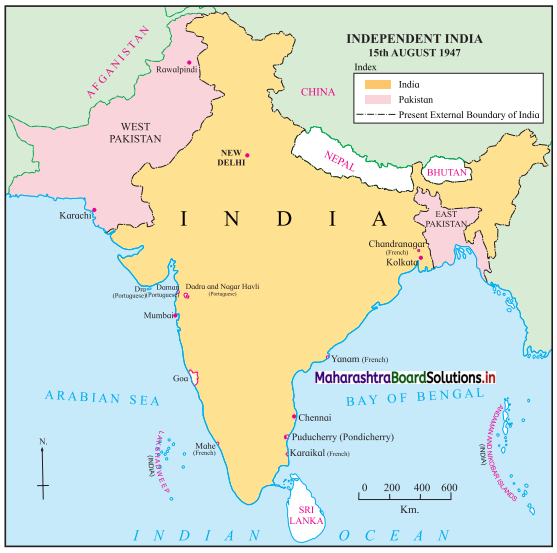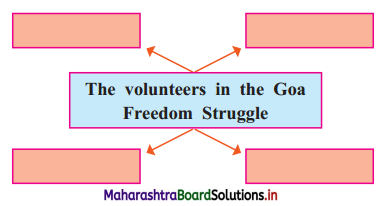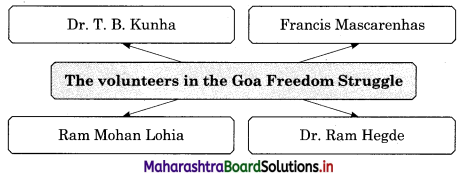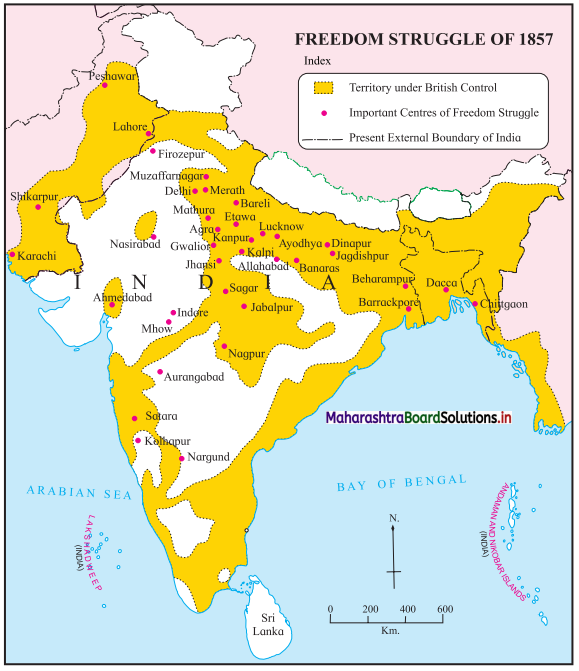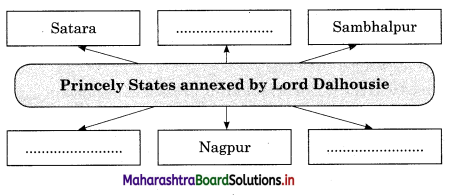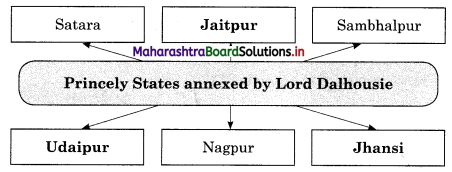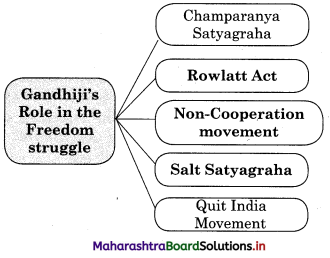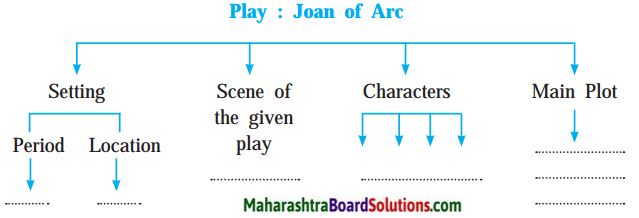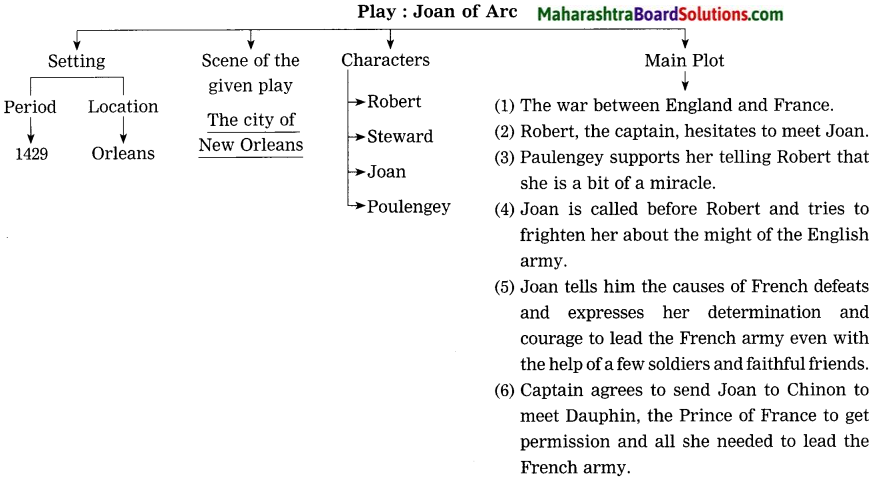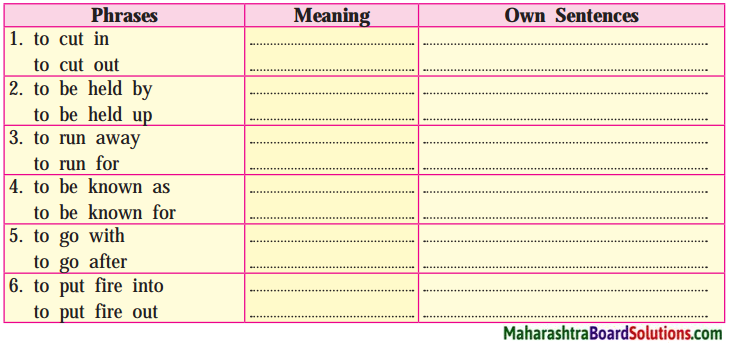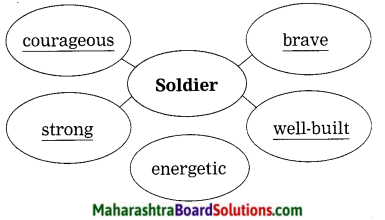Balbharti Maharashtra State Board Class 12 Economics Important Questions Chapter 2 Utility Analysis Important Questions and Answers.
Maharashtra State Board 12th Economics Important Questions Chapter 2 Utility Analysis
1. [A] Choose the correct option.
Question 1.
Form Utility increases when –
(a) dress stitched from cloth.
(b) change in the format of given material.
(c) river water diverted towards farm.
(d) pot made from clay.
Options :
(1) a, b, c
(2) b, c, d
(3) a, b, d
(4) a, b, c, d
Answer:
(3) a, b, d

Question 2.
Blood donation is an example of –
(a) place utility
(b) knowledge utility
(c) service utility
(d) form utility
Options ;
(1) a, b, c
(2) b, c, d
(3) a, b, d
(4) none of these
Answer:
(4) none of these
Question 3.
With an increase in consumption of commodity, MU curve –
(a) slopes downward
(b) goes upward
(c) turns backward
(d) shows negative slope
Options :
(1) a, d,
(2) a, b, c
(3) a, b,
(4) a, c, d
Answer:
(1) a, d,
Question 4.
After a point of satiety, any additional consumption of commodity results into –
(a) negative MU
(b) diminishing TU
(c) disutility
(d) maximum TU
Options :
(1) a, b, d
(2) a, b, c
(3) a, c, d
(4) None of these
Answer:
(2) a, b, c
Question 5.
Want satisfying power of a commodity is called –
(a) usefulness
(b) satisfaction
(c) happiness
(d) utility
Options :
(1) a, b
(2) b, d
(3) d
(4) a, c
Answer:
(3) d
Question 6.
Zero MU is described as
(a) disutility
(b) point of satiety
(c) dis-satisfaction
(d) maximum TU
Options :
(1) a, b
(2) b, d
(3) b, c, d
(4) a, b, c, d
Answer:
(2) b, d

(B) Complete the Correlation
(1) Fan in summer : Time utility :: Sweater in Shimla : …………..
(2) Additional Utility : Marginal utility :: Aggregate utility : …………..
(3) Maximum TU : Zero MU :: TU declines : …………..
(4) Measuring in numbers : …………..:: Higher or Lower level: Ordinal measurement
(5) Point of satiety : ………….. :: Beyond point of satiety: Dissatisfaction
(6) Transport of goods : ………….. :: Storage of goods : Time utility
(7) Want satisfying power : ………….. :: Use value of a commodity : Usefulness
(8) Homogeneity : Assumption of the law of DMU :: Hobbies : …………..
(9) Increases at a diminishing rate : Total Utility :: Goes on diminishing : …………..
(10) Consumer : To obtain maximum satisfaction :: …………..: To frame various economic policies
Answers:
(1) Place Utility
(2) Total Utility
(3) Negative MU
(4) Cardinal measurement
(5) Full satisfaction
(6) Place utility
(7) Utility
(8) Exception of law of DMU
(9) Marginal Utility
(10) Government
(C) Give economic terms.
(1) Want satisfying capacity of a commodity.
(2) Treatment given by a doctor to a patient.
(3) Goods sold by shopkeeper to consumer.
(4) Addition made to TU by consuming one more unit of a commodity.
(5) Aggregate of utilities derived from all units.
(6) Marginal utility becomes negative beyond the point of satiety.
(7) Utility created due to change in the structure of given material.
(8) A state of mind to feel happy.
(9) A feeling of lack of satisfaction.
(10) The urgency to satisfy want immediately.
Answer:
(1) Utility
(2) Service Utility
(3) Possession Utility
(4) Marginal Utility
(5) Total Utility
(6) Disutility
(7) Form Utility
(8) Satisfaction
(9) Want
(10) Intensity
(D) Find the odd word out:
(1) Form Utility, Time Utility, Date Utility, Place Utility.
(2) Rationality, Continuity, Reasonability, Indivisibility.
(3) Sum, Aggregate, Total, Additional.
(4) Disutility, Negative utility. Maximum TU, Declining TU.
(5) Diminishing, Declining, Developing, ; Decreasing.
(6) Miser, Drunkard, Power, Rational consumer.
Answer:
(1) Date utility
(2) Indivisibility
(3) Additional
(4) Maximum TU
(5) Developing
(6) Rational consumer
(E) Complete the following statements.
Question 1.
Utility depends upon ………………..
(a) intensity of want
(b) income of a consumer
(c) quality of a product
(d) cardinal measurement
Answer:
(a) intensity of want
Question 2.
When TU declines, MU ……………………………..
(a) is zero
(b) increases
(c) remains constant
(d) becomes negative
Answer:
(d) becomes negative
Question 3.
Consumer’s equilibrium is attained when
(a) MUX > Px
(b) MUX = Px
(c) MUX < Px
(d) MUX = zero
Answer:
(b) MUX = Px

Question 4.
Electricity can be used in Fan, TV, iron, computer, etc. because utility is ……………
(a) subjective concept
(b) multi-purpose
(c) basis of demand
(d) morally colourless
Answer:
(b) multi-purpose
Question 5.
The sum of all marginal utilities from the consumption of a commodity is called ………………
(a) place utility
(b) additional utility
(c) total utility
(d) time utility
Answer:
(c) total utility
[F] Choose the wrong pair :
I.
| Group ‘A’ |
Group ‘B’ |
| 1. Prof. Marshall |
Law of DMU |
| 2. Total utility |
Utility from last unit |
| 3. Cardinal measurement |
Assumption of law of DMU |
| 4. Service utility |
Knowledge by teacher |
Answer:
Wrong pair : Total utility – Utility from last unit
II.
| Group ‘A’ |
Group ‘B’ |
| 1. Disutilit |
Negative MU |
| 2. Homogeneity |
Identical unit |
| 3. Law of DMU |
Explained by Prof. Gossen |
| 4. Maximum TU |
Zero MU |
Answer:
Wrong pair : Law of DMU
Explained by Prof. Gossen
[G] Choose the correct pair :
I.
| Group ‘A’ |
Group ‘B’ |
| 1. Total utility |
(a) Point of Satiety |
| 2. Zero MU |
(b) Furniture from wood |
| 3. Time utility |
(c) Aggregate of utilities |
| 4. Form utility |
(d) Apples for Kashmir |
|
(e) Organ donation |
Options :
(1) 1 – a, 2 – c, 3 – e, 4 – b.
(2) 1 – c, 2 – e, 3 – d, 4 – b.
(3) 1 – c, 2 – a, 3 – e, 4 – b.
(4) 1 – e, 2 – a, 3 – c, 4 – d.
Answer:
(3) 1 – c, 2 – a, 3 – e, 4 – b.
II.
| Group ‘A’ |
Group ‘B’ |
| 1. Ordinal measurement |
(a)Maximum TU |
| 2. Principles of Economics |
(b) MUX>PX |
| 3. Point of satiety |
(c) Prof. Alfred Marshall |
| 4. Consumer’s equilibrium |
(d) Grading of utility |
|
(e) MUX = PX |
Options :
(1) 1 – d, 2 – c, 3 – a, 4 – e.
(2) 1 – c, 2 – a, 3 – b, 4 – b.
(3) 1 – d, 2 – a, 3 – b, 4 – c.
(4) 1 – b, 2 – e, 3 – d, 4 – c.
Answer:
(1) 1 – d, 2 – c, 3 – a, 4 – e.
2.[A] Identify and explain the concept from given illustrations.
Question 1.
Tanvi took umbrella while going out as it started raining.
Concept: Time utility.
Explanation : When Utility of a commodity increases during particular time period, it is called time utility.
Tanvi is using umbrella, when it is raining Ans. so, it is an example of time utility.
Question 2.
A goldsmith made a beautiful golden necklace.
Answer:
Concept: Form utility.
Explanation : When utility is created due to change in the form of given material it is known as form utility.
So, furniture from wood, dress from cloth, jewellery from gold, etc. are examples of form utility.
Thus, necklace made from gold is an example of form utility.
Question 3.
Deepak purchased bricks and transported to Thane at his construction site.
Answer:
Concept : Place utility.
Explanation : When utility arises due to change in the place of its utilisation, it is called place utility.
Transport of goods creates place utility. In this example, bricks are transported from place of production to place of utilization. So it is an example of place utility.
Question 4.
Mugdha bought raw mangoes and made pickle from it.
Answer:
Concept: Form utility.
Explanation : When utility increases due to change in the shape, structure or form of material, it is called form utility. So, pickle made from raw mangoes, is an example of form utility.

Question 5.
Aditi went to Beauty Parlour to cut her hairs.
Answer:
Concept: Service utility.
Explanation : When service is provided by one person to another, it is called service utility.
It includes services rendered by professionals like doctors, lawyers, teachers, etc.
In this case, a beautician has given service to Aditi.
So, it is an example of service utility.
(B) Distinguish between
Question 1.
Utility and Usefulness.
Answer:
| Utility |
Usefulness |
| 1. Utility is the capacity of a commodity to satisfy human wants. |
(a) Anything (goods or services) are useful if they satisfy human want and generate human welfare. |
| 2. A product may have utility irrespective of the commodity is useful or harmful, desirable or undesirable. |
(b) A product is useful only when it is desirable or beneficial and does not do any harm to a person. |
| 3. All commodities have utility such as car, clothes, even harmful products like drugs, liquor, cigarettes, narcotics, etc. |
(c) Products such as food items, medicine, clothes, etc. are useful. Also services such as education, recreation are useful to people. |
| 4. The term utility is subjective in nature as it changes from person to person, from place to place and from time to time. |
(d) The term usefulness is absolute in nature, it never changes. |
Question 2.
Utility and satisfaction.
Answer:
| Utility |
Satisfaction |
| 1. Utility is a want satisfying capacity possessed by a commodity. |
(a) Satisfaction is actual realisation from consumption of a commodity. |
| 2. It is what the commodity possesses. |
(b) It is what the commodity gives. |
| 3. It is a means. |
(c) It is an end. |
| 4. It is expected satisfaction before consumption. |
(d) It is actual realisation which comes after consumption. |
Question 3.
Place Utility and Time Utility.
Answer:
| Place Utility |
Time Utility |
| 1. Place utility is created by changing the place of utilisation. |
(a) Time utility is created by changing the time of utilisation. |
| 2. Transporting goods from one place to another, generally from place of abundance to place of scarcity, from place of manufacturing to place of consumption (Market), etc. |
(b) Storing of goods during abundance and releasing them during scarcity or goods are warehoused from time of production to time of consumption. |
| 3. All types of transport service create place utility. |
(c) Warehousing service create time utility. |
| 4. E.g. Food grains from village farm are sold in city markets. |
(d) E.g. Wheat stored during harvest time and released during off season. |
Question 4.
Total Utility and Marginal Utility.
Answer:
Total Utility :
- Total utility is the sum total of utilities derived from the consumption of all units in a given stock of a commodity.
- TU =Σ MU
- TU increases but at a diminishing rate.
- At point of satiety TU is maximum.
- After point of satiety TU starts diminishing.
- Numerical value of TU is always positive.
- TU indicates value-in-use.
- When TU is maximum, the MU is zero.
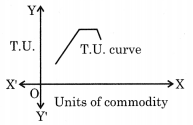
Marginal Utility :
- Marginal utility is the additional utility derived from consuming additional unit of a commodity.
- MUn = TUn – TUn-1
- MU continuously diminishes.
- At point of satiety MU is zero.
- After point of satiety MU becomes negative.
- Numerical value of MU can be positive, negative or zero.
- MU indicates value-in-exchange.
- When the MU is maximum the TU is minimum.
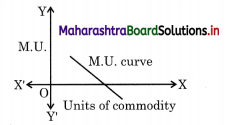

Question 5.
Form Utility and Service Utiliity.
Answer:
Form Utility :
- Form utility arises when the structure of given material changes.
- Furniture made out of wood is an example of form utility.
- It is related to material welfare.
- Form utility is mainly created by artisans like tailor, carpenter, etc.
Service Utility :
- It arises when service is rendered by one person to another.
- Knowledge given by teacher to student is an example of service utility.
- It is related to non-material welfare.
- Service utility is mainly created by professionals like doctor, lawyers, etc.
Question 6.
Knowledge Utility and Possession Utility.
Answer:
Knowledge Utility:
- Knowledge utility arises when a person acquires knowledge regarding a product.
- Use of mobile, computer, etc. creates knowledge utility.
- In this case, a consumer is interested to know various functions of product.
- Knowledge utility increases due to utilisation.
Possession Utility:
- Possession utility arises when the ownership of a product is transferred from one person to another.
- Sale and purchase of goods creates possession utility.
- In this case, a consumer is interested to satisfy his wants.
- Possession utility increases due to demand.
Question 7.
Form Utility and Time Utility.
Answer:
Form Utility :
- Form utility arises when the structure of given material changes.
- E.g. Furniture made out of wood.
- Technology and intelligence creates form utility.
Time Utility:
- Time utility is created by changing the time of utilisation.
- E.g. Wheat stored during harvest season and released during off season.
- Warehousing creates time utility.
3. Answer the following questions:
Question 1.
Critically evaluate the law of Diminishing Marginal Utility.
OR
Explain the limitations or shorcomings of law of DMU.
Answer:
Critical evaluation of the Law of DMU is as follows:
(1) Unrealistic Assumptions : The law of DMU is based upon some unrealistic assumptions like homogeneity, continuity, rationality, constancy, etc.
In reality, it is very difficult to fulfil all these ssumptions at a time.
(2) Cardinal Measurement – not possible : The law assumes that, utility is cardinally measurable. It is necessary for the law to express schedule indicating MU and TU. It helps to add, subtract and compare utilities, In the real sense, utility is a psychological concept so it cannot be measured cardinally i.e. in numbers.
(3) Not applicable to Indivisible Goods : The law assumes divisibility. So it is not applicable to indivisible or bulky goods like car, T.V. set, house, etc. which are not divisible.
It is not possible to compare MU from commodity which are normally purchased, once in a life time.
(4) Constant MU of Money: The law assumes that MU of each unit of money is constant. But, in reality, MU of money declines as its stock increases.
Critics also argue that MU of money differs from person to person. It is affected by changes in price level, stock of money, rate of interest, etc.
(5) Restricted to satisfaction of Single Want : The law of DMU has limited applicability. It analyses the satisfaction derived from single want.
In reality, human wants are multiple in nature i.e. a person has to satisfy many wants at a time.
Though, law of DMU is criticized, it is important and popular in economics, because it explains economics behavior of a rational consumer.
Question 2.
Explain the significance importance of Law of Diminishing Marginal Utility.
Answer:
The law of DMU has universal applicability so it is an important law in economics.
Importance or significance of the law of DMU is as follows :
(1) Useful to Consumers : The law is important to the consumer because it helps the consumer to maximize his satisfaction.
It creates awareness among the consumers 5 to get maximum satisfaction with limited resources.
(2) Useful to the Government : The law ; guides the government in framing various economics policies like progressive tax policy, pricing policy, trade policy, import export policy, etc. so as to maximise
economic welfare of the society.
(3) To understand Paradox of Value : The law of DMU helps us to understand paradox of values, i.e. value-in-use and value-in-exchange.
Some goods have more value-in-use but less value-in-exchange like air, water, sunlight, etc. while some goods have less value-in-use but high value-in-exchange like gold, diamond, etc. Greater value-in-use denotes high total utility whereas, more value in exchange denotes higher marginal utility.
(4) Basis of Law of Demand : The law of demand is based on the law of DMU.
A consumer compares MU with price of a commodity. He purchases till MU equals price. When a consumer buys more and more units of a commodity, his MU diminishes. It means, a consumer would buy more only at a lower price which is a basis of law of demand.

Question 3.
Explain the features / characteristics of Utility.
Answer:

(1) Multi-purpose : Utility is said to be multi-purpose because a commodity can be used to satisfy several wants. It can satisfy wants of more than one person at a time.
E.g. milk has multi-purpose utility. It can be used to make coffee, ice- cream, milk-shake, tea, etc.
Similarly, in case of commodities like coal, electricity, etc. utility is multi-purpose.
(2) Relative Concept : Utility is a relativeconcept because it is related to time, place and person. It changes from time to time, place to place and from person to person.
E.g. fan has greater utility in summer than
winter, sweater has greater utility in cold regions.
(3) S ubjective Concept: Utility is a subjective term. It varies from person to person. It differs on the basis of taste and preferences, habits, likes, dislikes, profession, situation, etc. e.g. chalk has utility for teachers and not for doctors. Fish has utility for non¬vegetarian person etc.
(4) Basis of Demand : A person will demand only those commodities which give him utility. No utility means no demand, so utility is the basis of demand.
E.g. a student demands a book because he has utility of a book. Thus, utility creates demand for a product.
(5) Intensity of Want: Utility of a commodity is greater if a want is most urgent, whereas, utility is less if the intensity of want is less. Utility diminishes when the urgency of want declines. E.g. a thirsty person gets more utility from the first sip of water than the next one.
(6) Measurement of Utility : Utility is a psychological concept. So utility cannot be measured cardinally, that is, in numbers. Ordinal measurement, i.e. higher or lower level of utility can be measured.
E.g. a hungry person may experience higher or lower utility after having food. However, X it is assumed that cardinal measurement of i utility is possible, for the validity of the law 5 of diminishing marginal utility.
(7) Utility is morally Colourless : Utility is ethically neutral concept. It has no moral consideration. It is morally colourless. It does not consider whether a want is good or bad, moral or immoral, desirable or undesirable. A commodity can be used to satisfy any kind of want. It can be useful or harmful.
E.g. a knife can be used to cut vegetables, as well as, it can be also used to harm somebody. Thus, utility does not have ? ethical consideration.
(8) Utility differs from Usefulness : Utility and usefulness are different concepts. Utility means want satisfying capacity of a commodity whereas usefulness means use value of a commodity.
Some commodities have both, utility and usefulness. E.g. watch, pen, etc.
However, some commodities have utility but no usefulness.
e.g. cigarette has utility for those who smoke but it is not at all useful as it has an adverse effect on human health.
(9) Utility differs from Pleasure : There is a difference between utility and pleasure, Certain commodities which possess utility, may not give pleasure.
E.g. a course of injections given to patient, has utility because it cures him however, it may not give pleasure or happiness as it is a painful experience.
(10) Utility differs from Satisfaction : Utility and satisfaction, interrelated concepts but, utility is not same as satisfaction. Utility refers to power of a good to a satisfy human want. Satisfaction is a state of mind to feel happy.
Utility arises before the consumption of a commodity. However, satisfaction is received after the consumption of a commodity. It is because, utility is anticipated satisfaction, whereas, satisfaction is actual realisation.
Utility is related to commodity but satisfaction is experienced by a person.
Question 4.
What are the different types or forms of utility?
Answer:
Types of utility :
- Form utility
- Place utility
- Service utility
- Knowledge utility
- Possession utility
- Time utility
Types of utility are explained as under:
(1) Form utility : It arises due to a change in the shape of an object. When utility is created because of change in the structure or form of a given material, it is known as form utility.
E.g. furniture made of wood, dress from cloth, jewellery from gold, etc.
(2) Place utility : Utility changes from place to place. When utility arises due to change in the place of its utilisation, it is called as place utility. Transport of goods and services creates place utility.
E.g. utility of river water increases when it is diverted towards farm.
Shawls have greater utility in cold regions than any other place.
(3) Service utility : When service is provided by professionals to another person, it creates service utility. It includes services rendered by Doctor to patient, Lawyer to client, Teacher to student, etc.
(4) Knowledge utility : In this case, utility increases when a person acquires knowledge regarding specific product.
For example, when a consumer knows about various functions of a laptop, its utility increases, Similarly, use of mobile, computer, sewing machine etc. creates knowledge utility.
(5) Possession utility : It is related to the ownership of goods. When the ownership of a product is transferred from one person to another, it creates possession utility.
E.g. transfer of ownership of food grains from farmer to consumer.
Thus, possession utility arises when goods are transferred from sellers to buyers.
(6) Time utility : When utility of a commodity changes due to change in time period, it is called time utility.
E.g. an umbrella has greater time utility during rainy season.
Time utility also takes place when goods are stored and used as per the requirement. Time utility varies from season to season or from situation to situation.
So, blood donation creates time utility.
4. State with reasons whether you agree or disagree with the following statements:
Question 1.
Utility is a subjective concept.
Answer:
Yes, I agree with this statement.
It is a psychological concept. It is the mental assessment of a commodity. So utility differs from person to person because of difference in taste, preference, likes and dislikes of a person e.g., Chalks have more utility to a teacher than a student.

Question 2.
Utility and happiness are different.
Answer:
Yes, I agree with this statement.
- Utility is want satisfying capacity of a commodity and happiness is an enjoyable experience.
- When a commodity has utility it may not necessarily give happiness or pleasure or enjoyable experience to consumer. E.g., no one enjoys taking an injection or bitter medicine but they have utility to a patient.
Question 3.
Utility is ethically neutral.
OR
The concept of utility has no moral or ethical consideration. (Feb. ‘16)
Answer:
Yes, I agree with this statement.
- Utility is morally colourless concept.
- As long as a commodity possesses the want satisfying power, it has utility for a person irrespective of the fact that the commodity is good or bad, desirable or undesirable, moral or immoral.
- e.g., Knife has the utility for both a killer (for stabbing) and a housewife (as kitchen appliance).
- Similarly liquor has utility to a drunkard but from ethical point of view their consumption may be undesirable .
Question 4.
Utility means not usefulness.
Answer:
Yes, I agree with this statement.
Utility indicates the power of a good to satisfy human wants irrespective of whether it is good or bad or harmful. Whereas usefulness means that the commodity is beneficial or desirable. A commodity may have utility but may not be useful e.g., Cigarette is injurious to health. It is not useful but it has utility to a smoker.
Question 5.
Utility is a psychological term.
Answer:
Yes, I agree with this statement.
- Utility relates to consumer’s mental attitude and experience regarding a given commodity.
- So utility differs from person to person.
- The utility of a good cannot be the same for all individuals.
- This is due to difference in taste, preference, likes and dislikes.
- E.g. fish has utility to non-vegetarian but not to a pure vegetarian.
Question 6.
Utility depends on urgency of want Or Utility depends upon intensity of want.
Answer:
Yes, I agree with this statement.
- Utility for a commodity is dependent on the intensity of need for that commodity.
- If a want is very intense or urgent for the commodity concerned then he will find more utility from the commodity.
- As the intensity of want falls, its utility diminishes. For example first slice of bread will give more utility to a hungry person than the 2nd or 3rd slice of bread. Books have more utility to students just before exams and no utility after the exams.
Question 7.
Utility of same commodity for two c persons is different.
Answer:
Yes, I agree with this statement.
- Utility is affected by personal likes, dislikes, preference, habits, etc.
- Utility changes from person to person. It is subjective concept.
- It is psychological feeling and subject to change from person to person.
- E.g. Cigarette has utility to a smoker but it has no utility to non-smoker.
- Marginal Utility diminishes.
Question 8.
Marginal Utility diminishes.
Answer:
Yes, I agree with this statement.
- Marginal utility diminishes with increase in consumption of a commodity.
- When the stock of the commodity increases the intensity of want decreases so the utility diminishes.
- There is an inverse relation between the stock of commodity and.MU.
- The law of DMU states “The additional benefit which a person derives from a given increase in the stock of a
- thing, diminishes with every increase in the stock that he already has.
Question 9.
Utility can be measured cardinally.
Answer:
No, I do not agree with this statement.
- Utility being a psychological concept it cannot be quantified in numbers such as 10, 20, 30 so on.
- It is a feeling so can be only be expressed ordinally.
- It can be expressed as 1st, 2nd, 3rd and so on, in order of preference or can be graded.
It is intangible.
But Marshall has assumed that utility can be measured in cardinal numbers to explain the law of Diminishing Marginal Utility but different concepts.
Question 10.
Utility and satisfaction are different concepts.
Answer:
Yes, I agree with this statement.
- Utility is the quality possessed by the commodity before consumption of the goods. It is expected satisfaction.
- Satisfaction is actual realisation, which is derived after the consumption.
- Utility is the means and satisfaction is the end result of consumption.
- Utility is what commodity possesses whereas satisfaction is what we experience after consumption.
- Utility and satisfaction are synonyms but different concepts.

Question 11.
It is more appropriate to tax the rich in excess than the poor.
Answer:
Yes, I agree with this statement.
- The law of diminishing marginal utility supports the progressive tax system.
- The rich are taxed more because they can easily bear the burden of heavy tax as they have more stock of money. Therefore, they find less MU in money.
- The poor have less stock of money. Therefore, they find more MU in money. So they are taxed less.
- In this way the Government follows the “Principle of Equity” while taxing the people.
- Also indirect tax on mass consumption goods or necessaries are less compared to the luxury goods.
Question 12.
The hobby of stamp collection is not a real exception to the law of Diminishing Marginal Utility.
Answer:
Yes, I agree with this statement.
- It is wrongly believed that the hobby of stamp collection is an exception to the law of DMU.
- It is observed that every successive stamp collected gives more MU to the person.
- But in reality a person collects different types of stamps. Thus it violates the assumption of homogeneity and continuity.
- If a person is asked to collect the same type of stamp again and again the MU will= diminish. Therefore, the hobby of stamp collection is not a real exception to law of DMU. It is an apparent exception.
Question 13.
There are no real exceptions to the law of DMU.
Answer:
Yes, I agree with this statement.
[Note : For answer refer Q.6. (1) (D)
Schedule and Diagram :
The law can be explained with the help of following schedule and diagram :
| Units of Commodity |
Marginal Utility (M.U) |
| 1 |
10 |
| 2 |
8 |
| 3 |
6 |
| 4 |
4 |
| 5 |
2 |
| 6 |
0 |
| 7 |
-2 |
The above given schedule shows that MU goes on diminishing with an increases in units of commodity consumed.
Graphical Presentation :

In the above given diagram, X-axis indicates units of commodity and Y-axis measures marginal utility.
Various points are plotted on the graph which indicates MU derived from each unit of commodity consumed.
When all these point are joined, we get MU curve. It slopes downward from left to right. It shows that MU diminishes as consumption of a commodity increases.
The shaded portion of the diagram shows negative utility. It is because, beyond a certain level, further consumption of a commodity results into disutility.
Question 14.
Law of DMU is important in practice.
Answer:
Yes, I agree with this statement.
The law of DMU has universal applicability so it is an important law in economics. Importance or significance of the law of DMU is as follows :
(1) Useful to Consumers : The law is important to the consumer because it helps the consumer to maximize his satisfaction.
It creates awareness among the consumers 5 to get maximum satisfaction with limited resources.
(2) Useful to the Government : The law ; guides the government in framing various economics policies like progressive tax policy, pricing policy, trade policy, import export policy, etc. so as to maximise
economic welfare of the society.
(3) To understand Paradox of Value : The law of DMU helps us to understand paradox of values, i.e. value-in-use and value-in-exchange.
Some goods have more value-in-use but less value-in-exchange like air, water, sunlight, etc. while some goods have less value-in-use but high value-in-exchange like gold, diamond, etc. Greater value-in-use denotes high total utility whereas, more value in exchange denotes higher marginal utility.
(4) Basis of Law of Demand : The law of demand is based on the law of DMU.
A consumer compares MU with price of a commodity. He purchases till MU equals price. When a consumer buys more and more units of a commodity, his MU diminishes. It means, a consumer would buy more only at a lower price which is a basis of law of demand.
Question 15.
(i) When the MU is zero, TU is maximum.
Answer:
Yes, I agree with this statement.
OR
(ii) When MU is zero, TU diminishes.
Answer:
No, I do not agree with this statement.
- When MU is zero the TU is the maximum.
- MU is the additional utility derived from the consumption of last unit of commodity.
- The TU is the sum of utilities derived from all units of consumption.
- The inter relationship between MU and TU can be explained with the help of the schedule.
| Units of Commodity |
Marginal Utility (M.U) |
| 1 |
10 |
| 2 |
8 |
| 3 |
6 |
| 4 |
4 |
| 5 |
2 |
| 6 |
0 |
| 7 |
-2 |

- From the schedule it can be observed that when a consumer keeps on consuming the same commodity continuously the MU diminishes and TU increases but at a diminishing rate.
- At the point of satiety i.e., unit 5 the consumer enjoys maximum satisfaction. Therefore, the MU becomes zero and TU reaches maximum i.e., 28 units.
- Here the consumer is fully satisfied. If the consumer keeps on consuming further units of the commodity after satiety, he derives dissatisfactions. Therefore, the MU becomes Negative and TU also starts falling or decreasing.
- Thus, at the point of full satisfaction MU is zero and it intersects the ‘X’ – axis and TU is maximum

Question 16.
The law of DMU could be explained type of stamp again and again the MU will with example and diagram.
OR The law of DMU can be explained with schedule and graph.
Answer:
Yes, I agree with this statement.
Schedule and Diagram :
The law can be explained with the help of following schedule and diagram :
| Units of Commodity |
Marginal Utility (M.U) |
| 1 |
10 |
| 2 |
8 |
| 3 |
6 |
| 4 |
4 |
| 5 |
2 |
| 6 |
0 |
| 7 |
-2 |
The above given schedule shows that MU goes on diminishing with an increases in units of commodity consumed.
Graphical Presentation :

In the above given diagram, X-axis indicates units of commodity and Y-axis measures marginal utility.
Various points are plotted on the graph which indicates MU derived from each unit of commodity consumed.
When all these point are joined, we get MU curve. It slopes downward from left to right. It shows that MU diminishes as consumption of a commodity increases.
The shaded portion of the diagram shows negative utility. It is because, beyond a certain level, further consumption of a commodity results into disutility.
Question 17.
The diminishing Marginal Utility Curve goes upwards means it has a positive slope
Answer:
No, I do not agree with this statement.
(a) The MU curve slopes downwards from left to right and it has a negative slope as shown in the diagram.
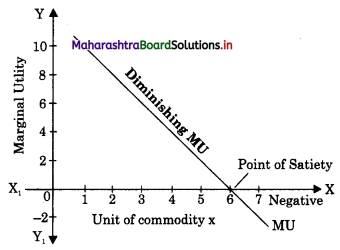
(b) The MU curve has a negative slope which indicates inverse relationship between the stock of the commodity and MU.
(c) The law states that the additional benefit which a person derives from a given increase in his stock of a thing diminishes with every increase in the stock that he already has.
(d) It means that the MU goes on diminishing with an increase in the stock of commodity consumed.
(e) It means that the intensity of want decreases.
(f) With increase in stock of commodity, the satisfaction derived decreases, so it has a negative slope.

Question 18.
The law of DMU depends upon assumptions.
Answer:
Yes, I agree with this statement.
OR
Homogeneity is the only assumption to law of DMU.
Answer:
No, I do not agree with this statement.
Assumptions of the law of DMU :
Assumptions are those conditions which are necessary for the validity of the law. They are as follows :
- Cardinal Measurement: The law assumes that utility can be measured cardinally i.e. in numbers. So, it is possible to express and compare the utility derived from each unit of commodity consumed.
- Homogeneity : It is assumed that all the units of commodity consumed are homogeneous or same. They are identical in case of size, shape, taste, colour, flavor, etc.
- Rationality : A consumer is assumed to be rational. His behaviour is normal from economic’s point of view. It means, he tries to get maximum satisfaction.
- Continuity : All units of commodity are consumed successively, one after another, without time interval.
- Reasonability : The law assumes that, all the units of commodity consumed are reasonable in size. The unit of measurement is neither too big nor too small e.g. a cup of tea, glass of water, etc.
- Divisibility : A commodity is assumed to be divisible. So it is possible to divide the units of commodity in a proper size.
- Constancy : It is assumed that related factors like income, taste and preference, habits, choice of a consumer remain constant. MU of money is also assumed to be constant.
- Single want: A given commodity is used to satisfy a single want of a person. So that it is possible to experience full satisfaction from a single want.
Question 19.
Marginal Utility and Total Utility are same.
Answer:
No, I do not agree with this statement.
MU and TU are different.
Total Utility :
- Total utility is the sum total of utilities derived from the consumption of all units in a given stock of a commodity.
- TU =Σ MU
- TU increases but at a diminishing rate.
- At point of satiety TU is maximum.
- After point of satiety TU starts diminishing.
- Numerical value of TU is always positive.
- TU indicates value-in-use.
- When TU is maximum, the MU is zero.

Marginal Utility :
- Marginal utility is the additional utility derived from consuming additional unit of a commodity.
- MUn = TUn – TUn-1
- MU continuously diminishes.
- At point of satiety MU is zero.
- After point of satiety MU becomes negative.
- Numerical value of MU can be positive, negative or zero.
- MU indicates value-in-exchange.
- When the MU is maximum the TU is minimum.

Question 20.
There are no criticisms to the law of DMU.
Answer:
No, I do not agree with this statement.
Answer:
There are many criticisms / limitations.
Critical evaluation of the Law of DMU is as follows:
- Unrealistic Assumptions : The law of DMU is based upon some unrealistic assumptions like homogeneity, continuity, rationality, constancy, etc.
In reality, it is very difficult to fulfil all these assumptions at a time.
- Cardinal Measurement – not possible : The law assumes that utility is cardinally measurable. It is necessary for the law to express schedule indicating MU and TU. It helps to add, subtract and compare utilities, concept so it cannot be measured cardinally i.e. in numbers.
- Not applicable to Indivisible Goods : The law assumes divisibility. So it is not applicable to indivisible or bulky goods like car, T.V. set, house, etc. which are not divisible.
It is not possible to compare MU from commodity which are normally purchased, once in a life time.
- Constant MU of Money: The law assumes that MU of each unit of money is constant. But, in reality, MU of money declines as its stock increases.
Critics also argue that MU of money differs from person to person. It is affected by changes in price level, stock of money, rate of interest, etc.
- Restricted to satisfaction of Single Want The law of DMU has limited applicability. It analyses the satisfaction derived from single want.
In reality, human wants are multiple in nature i.e. a person has to satisfy many wants at a time.
Though, law of DMU is criticized, it is important and popular in economics, because it explains economics behavior of a rational consumer.
Question 21.
Utility is a relative concept.
Answer:
Yes, I agree with this statement.
Relative Concept : Utility is a relative concept because it is related to time, place and person. It changes from time to time, place to place and from person to person.
E.g. fan has greater utility in summer than winter, sweater has greater utility in cold regions.
5. Study the following table / figures / passages and answer the questions :
Question 1.
Observe the given table and answer the questions:
| Units of Com. ‘X’ |
MU |
TU |
| 1 |
12 |
12 |
| 2 |
8 |
20 |
| 3 |
5 |
25 |
| 4 |
3 |
28 |
| 5 |
0 |
28 |
| 6 |
-2 |
26 |
(1) Draw MU and TU curve with the help of given schedule.
Answer:
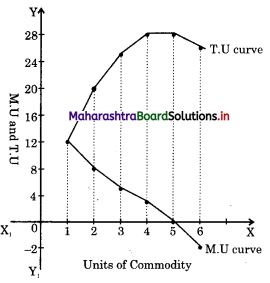
(2) What is TU at zero MU?
Answer:
T.U. is maximum, at zero MU.

(3) Complete the sentence :
With an increase in consumption, MU goes on diminishing and TU …..
Answer:
With an increase in consumption, MU goes on diminishing and TU goes on increasing at a diminishing rate.
(4) What happens to MU when TU falls?
Answer:
MU becomes negative when TU falls.
Question 2.
Observe the given table and answer the questions:
| Units of Com. ‘X’ |
TU Units |
MU Units |
| 1 |
6 |
6 |
| 2 |
11 |
5 |
| 3 |
15 |
4 |
| 4 |
15 |
0 |
| 5 |
14 |
-1 |
(1) Draw TU and MU curve.
Answer:
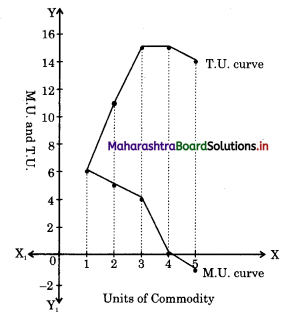
(2) Fill in the blanks :
(a) When total utility is maximum marginal utility is ……………..
Answer:
When total utility is maximum marginal utility is zero.
(b) When total utility falls, marginal utility becomes ……..
Answer:
When total utility falls, marginal utility becomes negative.
6. Answer in detail:
Question 1.
Explain the relationship between MU and Price.
Answer:
The relationship between MU & Price helps to understand, how the law of DMU forms ’ the basis of law of demand.
It is a perfect example of application of law of DMU practically. In this case, MU is converted in terms of money to understand this relationship and the comparison between MU & price.
Let us assume that 1 unit of MU = ₹ 10/- Market price per unit of commodity x = ₹ 50/- The table given below, explains the relationship between MU and price. It helps to know consumers equilibrium.

The above given table indicates that a consumer purchase units of commodity ‘x’ one after another. 2nd column shows MU derived from each unit. It goes on diminishing with every unit of commodity consumed.
To compare MU with price, it is necessary to ) convert MU in terms of money.
Let us assume that, 1 unit of MU = ₹ 10/- So, units of MU multiplied by ₹ 10/- (as shown in column
Market price of each unit of commodity ‘x’ is ₹ 50/- (as shown in column 4)
Column 5 shows comparison between MU and price.
It is observed that, for the first and second unit, MU (in terms of money) is greater than the price paid for them it means MUx > Px.
So, a rational consumer will be willing to buy 1st and 2nd unit of commodity ‘x’.
At the 3rd unit a commodity ‘x’ MU equals ) the price. So, the consumer can also think of purchasing it. Here, MUx = Px.
But, in case of 4th and 5th unit, MU is less than price. Therefore, a rational consumer will not purchase these units because MUx < Px
The relationship between MU and price can be summarised as follows :
1. When MU is greater than price, a consumer is willing to buy those units. They are called Intra- Marginal units (MUx > Px).
2. When MU becomes equal to market price, a consumer can also think of buying that unit. It is called Marginal unit (MUx = Px = Consumer’s equilibrium).
3. When MU is less than price, a rational consumer is not willing to buy them. They are called Extra-marginal units (MUx < Px) Thus, a rational consumer attains equilibrium where MUx = Px.
The relationship between MU and price helps to understand the law of demand.
Question 2.
Explain the various concepts of Utility.
Answer:
There are two main concepts of utility :
Marginal Utility (MU)
Total Utility (TU)
They are explained as follows :
1. Marginal Utility (MU) : MU refers to the additional utility derived by a consumer from the last unit of a commodity consumed. In simple words, MU is the addition made by one more unit of a commodity consumed.
2. Total Utility (TU) : TU means the sum of utilities derived by a consumer from all units of commodity consumed.
It is an aggregate of utilities derived from all units.
Symbolically, it can be represented as follows :
MU = Marginal Utility
TU Total Utility
MU1, MU2 , MU3, = Marginal Utilities
derived from each unit.
MUn = Marginal utility of nth unit.
MUn = TUn -TU(n-1)
TUn = Total utility of nth unit.
TU(n-1) = Total utility of nth previous unit.
TUn = ΣMUn or
TUn = MU1 + MU2 + …………………. +MUn
TU of nth unit = Summation of marginal utilities up to nth unit.

Question 3.
Explain the relationship between MU and TU.
Answer:
MU & TU are inter-related concepts but there is a difference between MU and TU because MU shows utility derived from each unit whereas, TU indicates summations of marginal utilities.
It can be explained with the help of following schedule –

The above given schedule indicates MU derived from each successive unit & TU – summation of MU’s.
On the basis of given schedule, MU curve and TU curve can be drawn, as shown in the following diagram.
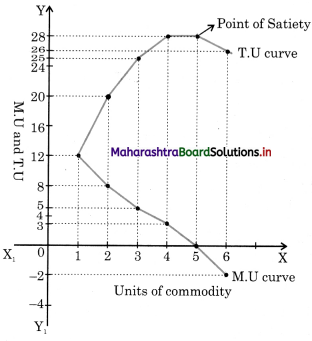
In the given diagram X’ axis indicates units of commodity and ‘Y’ axis measures TU & MU.
MU curve slopes downward whereas; TU curve goes upward.
MU curve shows zero and negative level of satisfaction whereas, TU curve shows maximum level of satisfaction.
The relationship between MU and TU can be summarized as follows:
- When the 1st unit of commodity is consumed, MU is equal to TU. (MU = TU)
- From 2nd consumption, MU goes on diminishing and TU increases at a diminishing rate. (MU↓↓↓. and TU ↑↑↑)
- At a full satisfaction level, MU becomes zero & TU reaches at maximum level. It becomes constant. It is called point of satiety. (MU zero, TU maxm)
- After a point of satiety, any additional consumption of unit results into negative MU while TU starts declining.
(MU —ve, TU↓)
- If any unit of commodity consumed beyond the point of satiety, consumer experiences dissatisfaction.
![]()
![]()
![]()
![]()
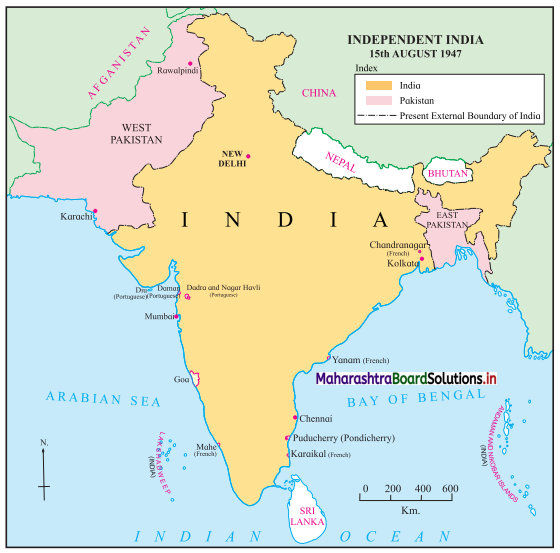
![]()
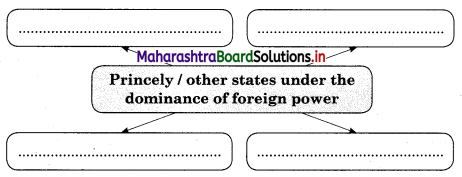
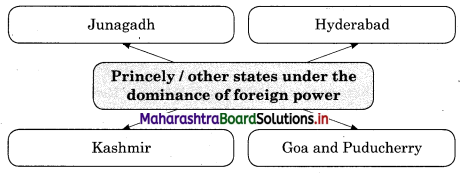
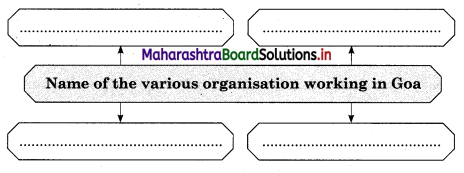
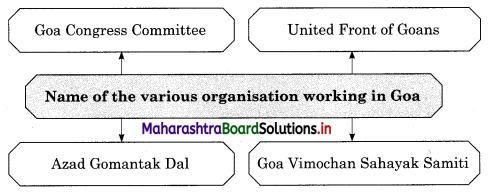
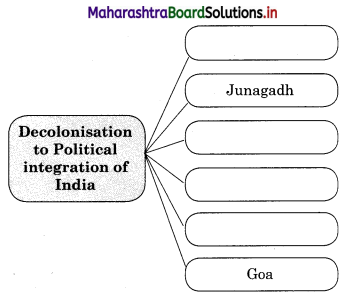
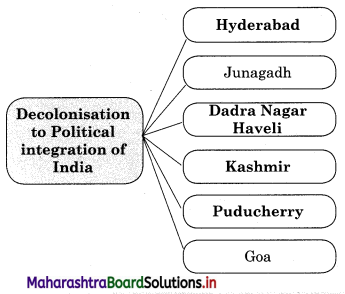
![]()
![]()
![]()
![]()
![]()











